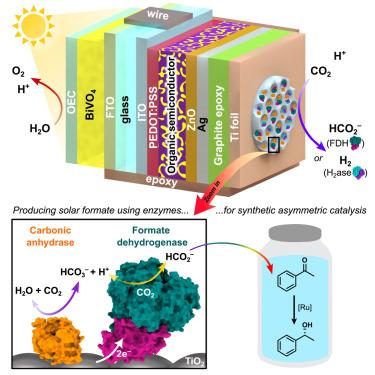Semi-artificial leaf interfacing organic semiconductors and enzymes for solar chemical synthesis
IF 35.4
1区 材料科学
Q1 CHEMISTRY, PHYSICAL
引用次数: 0
Abstract
Photoelectrochemical biohybrids combine the advantages of light-harvesting semiconductors and biocatalysts into a single compact device. However, limited device stability, the use of toxic elements, and non-innocent external components make a sustainable artificial photosynthetic reaction difficult to achieve. Here, we introduce organic photoelectrodes connected to an inverse opal TiO2 matrix that hosts efficient hydrogenase or formate dehydrogenase, driving direct solar fuel synthesis. By co-immobilizing carbonic anhydrase, the organic bulk heterojunction photobiocathodes generate onset potentials of 1 V vs. RHE and photocurrent densities of up to −8 mA cm−2 in a pH-neutral bicarbonate solution, attaining stable H2 production or selective CO2-to-formate conversion over 10 h. Sufficient aqueous formate was produced (∼2.5 mM) to serve as a hydride source for the asymmetric hydrogenation of acetophenone using a synthetic Noyori-Ikariya catalyst. The semi-artificial organic semiconductor—BiVO4 tandem leaves achieve a solar-to-fuel efficiency of 0.6% and a Faradaic yield of 87% for formate.

半人工叶界面有机半导体和酶的太阳能化学合成
光电化学生物杂化体将光收集半导体和生物催化剂的优点结合到一个单一的紧凑装置中。然而,有限的设备稳定性、有毒元素的使用以及非无害的外部成分使得可持续的人工光合反应难以实现。在这里,我们引入了有机光电极连接到反向蛋白石TiO2基质,该基质承载高效的氢化酶或甲酸脱氢酶,驱动直接太阳能燃料合成。通过共固定化碳酸酐酶,有机体异质结光生物阴极在ph中性碳酸氢盐溶液中产生1 V相对于RHE的起始电位和高达- 8 mA cm - 2的光电流密度,在10小时内实现稳定的H2生成或选择性的二氧化碳到甲酸转化。使用合成Noyori-Ikariya催化剂产生足够的甲酸水(~ 2.5 mM)作为苯乙酮不对称氢化的氢化物源。半人工有机半导体- bivo4串联叶片的太阳能-燃料效率为0.6%,甲酸的法拉第产率为87%。
本文章由计算机程序翻译,如有差异,请以英文原文为准。
求助全文
约1分钟内获得全文
求助全文
来源期刊

Joule
Energy-General Energy
CiteScore
53.10
自引率
2.00%
发文量
198
期刊介绍:
Joule is a sister journal to Cell that focuses on research, analysis, and ideas related to sustainable energy. It aims to address the global challenge of the need for more sustainable energy solutions. Joule is a forward-looking journal that bridges disciplines and scales of energy research. It connects researchers and analysts working on scientific, technical, economic, policy, and social challenges related to sustainable energy. The journal covers a wide range of energy research, from fundamental laboratory studies on energy conversion and storage to global-level analysis. Joule aims to highlight and amplify the implications, challenges, and opportunities of novel energy research for different groups in the field.
 求助内容:
求助内容: 应助结果提醒方式:
应助结果提醒方式:


